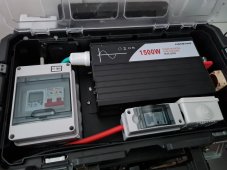meetyg
Solar Addict
- Joined
- Jun 4, 2021
- Messages
- 1,101
Hi.
I have a 220v AC/12v DC Xijia (CNSPower) 1500w inverter.
I'm using it in a portable solar generator setup.
The inverter doesn't have ground-neutral bonding, same as most of these types of inverters (Giandel, etc...).
The output of the inverter AC socket goes to a small panel box, which houses an AC breaker with ground fault protection (GFCI) and a watt meter. Then from this box, AC out goes to a 3 pin socket. See picture:

In general, I understand that for most portable uses, using it with a floating neutral is OK.
But for the GFCI to properly protect from ground faults (and electrocution) I understand that these two conditions must be met:
1. I need a ground-neutral bond, before the GFCI.
2. I need a real ground somewhere (e.g. ground rod)
Am I correct?
If I bond the ground-neutral before the GFCI, but do not have a true ground, would this be any more dangerous than just leaving the neutral floating?
Since this is a portable build, I might not always have a true ground/earthing available. That's why I'm asking...
Another reason I want a ground-neutral bond is because I might want to charge an EV from this portable generator. Most portable EV chargers check the bonding before allowing to charge the vehicle. Of course this would be pushing it a bit for a 1500w inverter, but there are some portable chargers which can be set to 6 amps AC, which at 220v would be around 1300w.
In case I will charge an EV, then I will make sure I have a true ground.
But the question is can I leave the ground-neutral bond, even when not really needing it, and when ground might not be available?
Thanks.
I have a 220v AC/12v DC Xijia (CNSPower) 1500w inverter.
I'm using it in a portable solar generator setup.
The inverter doesn't have ground-neutral bonding, same as most of these types of inverters (Giandel, etc...).
The output of the inverter AC socket goes to a small panel box, which houses an AC breaker with ground fault protection (GFCI) and a watt meter. Then from this box, AC out goes to a 3 pin socket. See picture:

In general, I understand that for most portable uses, using it with a floating neutral is OK.
But for the GFCI to properly protect from ground faults (and electrocution) I understand that these two conditions must be met:
1. I need a ground-neutral bond, before the GFCI.
2. I need a real ground somewhere (e.g. ground rod)
Am I correct?
If I bond the ground-neutral before the GFCI, but do not have a true ground, would this be any more dangerous than just leaving the neutral floating?
Since this is a portable build, I might not always have a true ground/earthing available. That's why I'm asking...
Another reason I want a ground-neutral bond is because I might want to charge an EV from this portable generator. Most portable EV chargers check the bonding before allowing to charge the vehicle. Of course this would be pushing it a bit for a 1500w inverter, but there are some portable chargers which can be set to 6 amps AC, which at 220v would be around 1300w.
In case I will charge an EV, then I will make sure I have a true ground.
But the question is can I leave the ground-neutral bond, even when not really needing it, and when ground might not be available?
Thanks.


